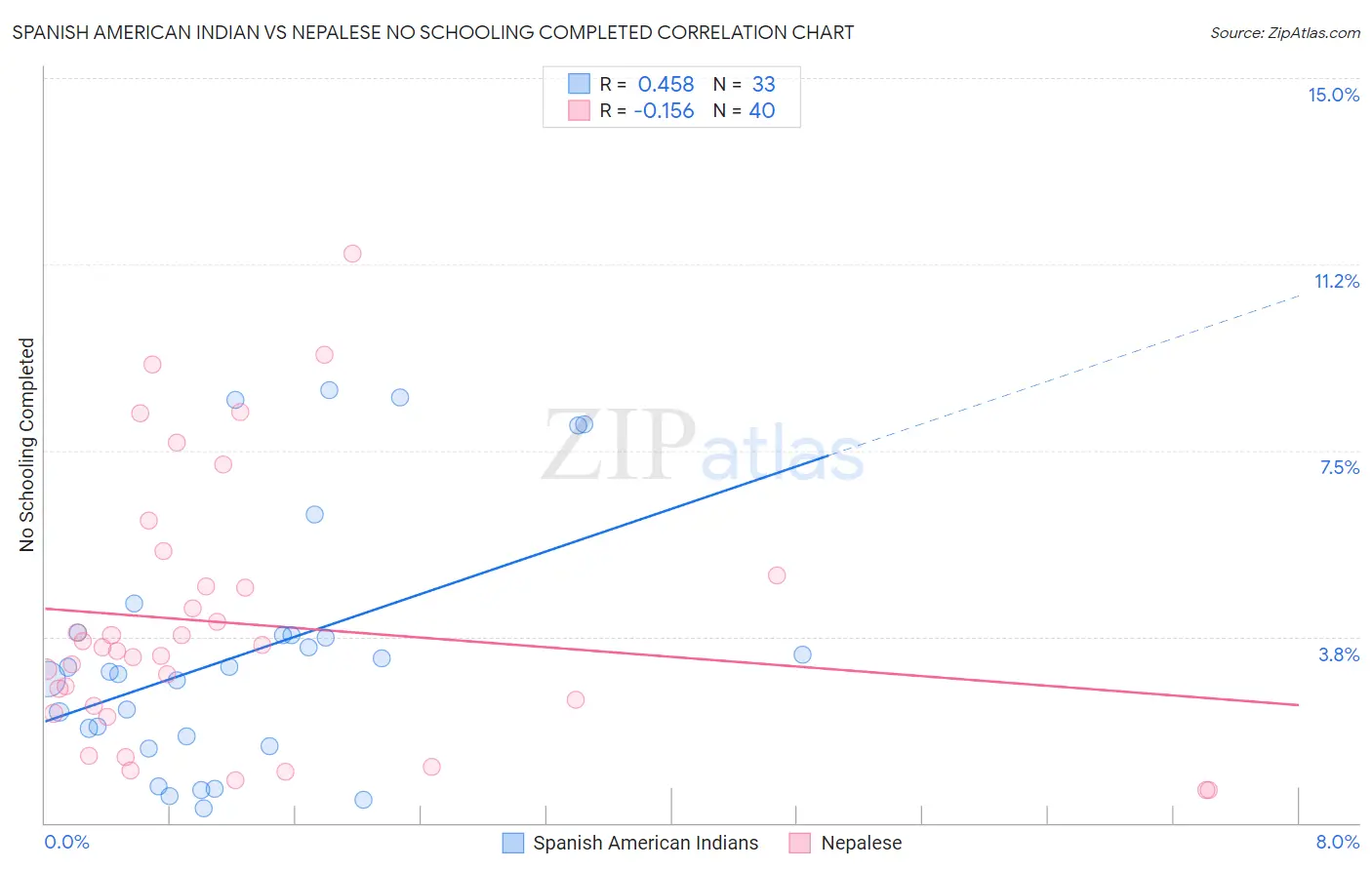Spanish American Indian vs Nepalese No Schooling Completed
COMPARE
Spanish American Indian
Nepalese
No Schooling Completed
No Schooling Completed Comparison
Spanish American Indians
Nepalese
4.2%
NO SCHOOLING COMPLETED
0.0/ 100
METRIC RATING
347th/ 347
METRIC RANK
3.8%
NO SCHOOLING COMPLETED
0.0/ 100
METRIC RATING
344th/ 347
METRIC RANK
Spanish American Indian vs Nepalese No Schooling Completed Correlation Chart
The statistical analysis conducted on geographies consisting of 73,096,872 people shows a moderate positive correlation between the proportion of Spanish American Indians and percentage of population with no schooling in the United States with a correlation coefficient (R) of 0.458 and weighted average of 4.2%. Similarly, the statistical analysis conducted on geographies consisting of 24,510,165 people shows a poor negative correlation between the proportion of Nepalese and percentage of population with no schooling in the United States with a correlation coefficient (R) of -0.156 and weighted average of 3.8%, a difference of 10.1%.

No Schooling Completed Correlation Summary
| Measurement | Spanish American Indian | Nepalese |
| Minimum | 0.30% | 0.66% |
| Maximum | 8.7% | 11.5% |
| Range | 8.4% | 10.8% |
| Mean | 3.4% | 4.0% |
| Median | 3.1% | 3.5% |
| Interquartile 25% (IQ1) | 1.6% | 2.3% |
| Interquartile 75% (IQ3) | 3.8% | 4.9% |
| Interquartile Range (IQR) | 2.2% | 2.6% |
| Standard Deviation (Sample) | 2.5% | 2.6% |
| Standard Deviation (Population) | 2.5% | 2.6% |
Demographics Similar to Spanish American Indians and Nepalese by No Schooling Completed
In terms of no schooling completed, the demographic groups most similar to Spanish American Indians are Immigrants from Yemen (4.1%, a difference of 1.5%), Immigrants from El Salvador (3.9%, a difference of 8.1%), Salvadoran (3.7%, a difference of 11.9%), Immigrants from Mexico (3.6%, a difference of 15.0%), and Immigrants from Central America (3.6%, a difference of 15.9%). Similarly, the demographic groups most similar to Nepalese are Salvadoran (3.7%, a difference of 1.7%), Immigrants from El Salvador (3.9%, a difference of 1.8%), Immigrants from Mexico (3.6%, a difference of 4.5%), Immigrants from Central America (3.6%, a difference of 5.3%), and Immigrants from Guatemala (3.6%, a difference of 6.4%).
| Demographics | Rating | Rank | No Schooling Completed |
| Mexicans | 0.0 /100 | #328 | Tragic 3.3% |
| Immigrants | Vietnam | 0.0 /100 | #329 | Tragic 3.3% |
| Immigrants | Armenia | 0.0 /100 | #330 | Tragic 3.3% |
| Japanese | 0.0 /100 | #331 | Tragic 3.3% |
| Central Americans | 0.0 /100 | #332 | Tragic 3.4% |
| Immigrants | Dominican Republic | 0.0 /100 | #333 | Tragic 3.4% |
| Guatemalans | 0.0 /100 | #334 | Tragic 3.5% |
| Immigrants | Cambodia | 0.0 /100 | #335 | Tragic 3.5% |
| Immigrants | Fiji | 0.0 /100 | #336 | Tragic 3.5% |
| Immigrants | Cabo Verde | 0.0 /100 | #337 | Tragic 3.5% |
| Bangladeshis | 0.0 /100 | #338 | Tragic 3.5% |
| Yakama | 0.0 /100 | #339 | Tragic 3.6% |
| Immigrants | Guatemala | 0.0 /100 | #340 | Tragic 3.6% |
| Immigrants | Central America | 0.0 /100 | #341 | Tragic 3.6% |
| Immigrants | Mexico | 0.0 /100 | #342 | Tragic 3.6% |
| Salvadorans | 0.0 /100 | #343 | Tragic 3.7% |
| Nepalese | 0.0 /100 | #344 | Tragic 3.8% |
| Immigrants | El Salvador | 0.0 /100 | #345 | Tragic 3.9% |
| Immigrants | Yemen | 0.0 /100 | #346 | Tragic 4.1% |
| Spanish American Indians | 0.0 /100 | #347 | Tragic 4.2% |